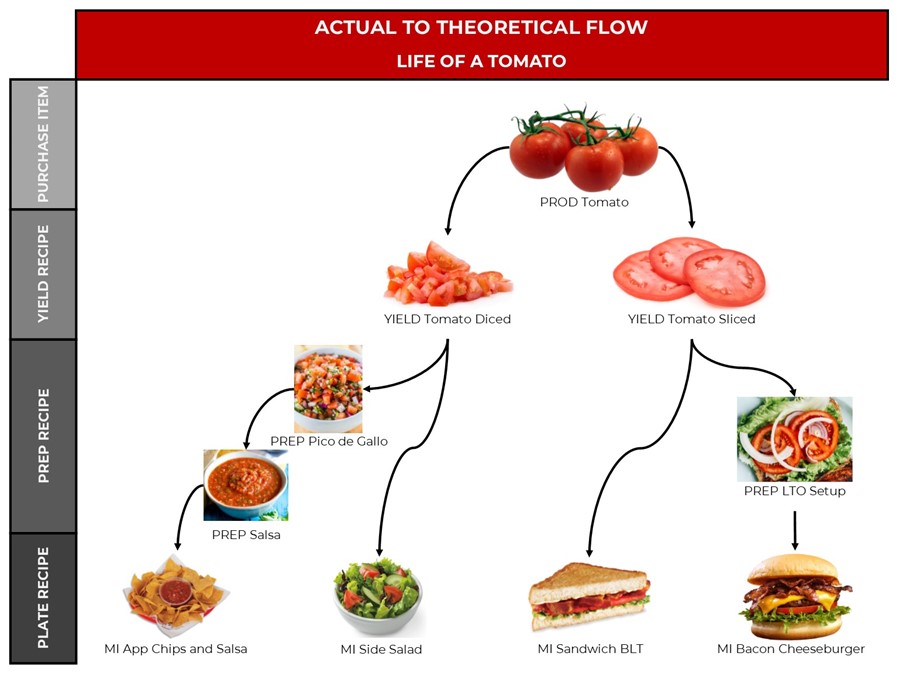When beginning to build out recipes, start with yield, then prep, and finally menu item recipes. Building out setups and yield recipes will save time in the later stages of setup. For instance, creating a setup recipe for lettuce, tomato, and onion, which is used on most burgers and sandwiches, will save time when selecting only one item (LTO Setup) versus all three items individually.
This also makes editing menu specifications easier as recipes change over time and as edits to the nested LTO recipe affect the ten burger and sandwich recipes versus editing each of the ten records separately.
This article complements the Recipe Item record training article. To learn more specifics on the record itself, click here.
Recipe Flow

The flowchart above displays the break out of a tomato, which is added in Inventory and prepared on various levels. This flowchart is a visual representation of how yield, prep, and menu item recipes are defined in R365. Below is a table that further defines Recipe Type examples.
|
Recipe Type |
Example |
Purpose |
Used in Transactions? |
|---|---|---|---|
|
Yield |
YIELD Tomato Diced |
Calculating yield for a raw item. May also be used in place of a UofM Equivalency (1 lb of whole tomatoes yields 2 cup diced tomato). The purpose of a yield recipe is to use it as an ingredient in other recipes and/or to count on Inventory Counts. |
Yes |
|
Prep |
PREP Pico de Gallo |
Calculating batch cost for a prepped item. The purpose of a prep recipe is to use it as an ingredient in other recipes and/or to count on Inventory Counts. |
Yes |
|
Menu Item (MI) |
MI Sandwich BLT |
Reporting plate cost & profit margins for menu engineering and linking to POS Menu Items for theoretical depletion of purchase items. |
No |
Build Recipes
These steps dictate the most important fields to fill out when creating yield, prep, and menu item recipes. For more details on this record, review the Recipe Item record training article.
Step 1: Naming Convention

Once a new Recipe Item record is created, it will open to the 'General' tab, where the Name and Measure Type should be entered. Use a naming convention, such as 'YIELD', 'PREP', and 'MI' to easily distinguish between the types of recipes from each other.
Step 2: Ingredients

Next, navigate to the 'Ingredients' tab. Use the Item selector to enter in the ingredients, their correct UofMs, and their Yield %, if necessary. The Batch and Portion Cost will populate after saving.
Step 3: Yield and Portion Quantities

Open the 'Recipe' tab and define the yield and portion quantities and UofMs. Number of portions calculates automatically based on yield. Cost Update Method defaults to 'Nightly', which will be desirable for almost all recipes.
Step 4: Save the Record
Save the record and repeat this process for all Recipes!
All other tabs and fields on the Recipe Item record are optional and explained in its training article. By starting with these initial required fields, recipes can be entered in R365 and linked up to POS Menu Items sooner. As time allows, return and fill in prep minutes and tools, recipe pictures, and steps, as desired.